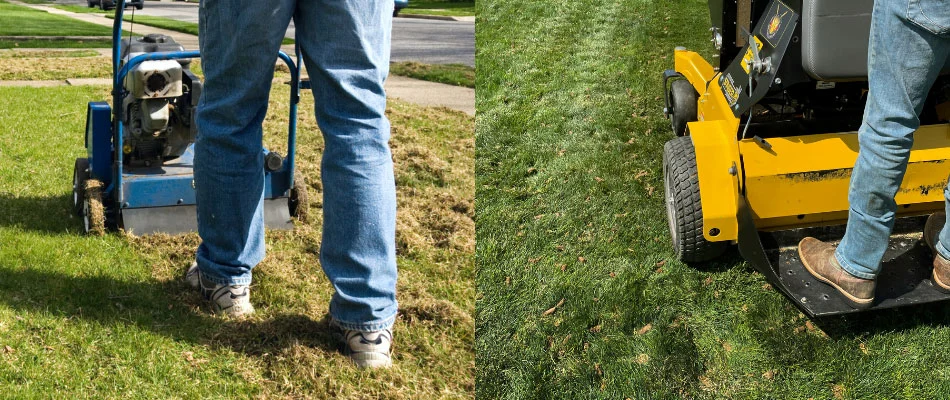Home » Power Raking vs Aerating: How to Manage Lawn Thatch

Achieving a lush and healthy lawn is the goal of every homeowner, but it requires consistent maintenance and care. Managing lawn thatch by power raking and core aerating are two common lawn care methods that can help your lawn look its best. However, it’s important to understand the differences between these two lawn care practices and how they affect your lawn’s health.
Thatch is a layer of dead grass and other organic matter that accumulates between the green grass blades and the soil surface. It is a naturally occurring process where soil organisms break down dead lawn stems and roots.
A small thatch layer of less than one-half inch is normal and acceptable. Without proper care, this layer can become thick, dense, and spongy, preventing water and nutrients from reaching the soil and creating an unhealthy environment for your lawn.
Grass clippings do not contribute to thatch accumulation and should be returned to the lawn. A healthy thatch layer of manageable grass clippings actually provides a constant source of slow-release nitrogen to the lawn as well as acts as a soil moisture barrier.
Refer to the publication Don’t Bag It! from the University of Idaho Extension to learn more about the benefits and best practices of returning grass clippings to the lawn.
Lawn dethatching involves removing this layer of thick thatch to promote a healthier lawn environment. Homeowners are often unsure which method is the best for removing thatch.
Power raking and core aerating are both used to manage a thick thatch layer. Power raking is a powerful and deep lawn raking that removes debris. Core aerating extracts 3″ sized plugs of soil, turf, and thatch from the lawn.
Power raking can help remove dead organic material from a lawn which can improve the oxygen and moisture transfer process. Removing this layer of dead debris will help your lawn breathe properly and improve fertilizer uptake.
However, it can have some negative impacts on your lawn if done excessively or improperly. Compacted soil that has not been aerated often will have a shallow root system and removing too much lawn debris can damage lawn roots and expose them to the sun and other elements. This can cause lawn roots to dry out and die.
It’s important to keep in mind that power raking not only removes dead organic material but also removes large amounts of living grass.
Another point to consider is that power raking can be a time-consuming and labor-intensive task, making it impractical for some homeowners. There will be a great deal of grass to rake up and haul off of your property.
It’s important to note that dethatching is not always necessary, and some lawns may not have a significant thatch buildup. The University of Idaho Extension recommends limiting thatch removal to 1/2 inch or less to avoid damaging your lawn.
Power raking should only be performed when necessary. Watering and mulching properly will reduce your need for deep power raking.
Lawn aerating is a simple but effective process that can make a big difference in the overall health of your lawn.
A machine with rotating tines punctures the lawn and extracts small plugs of soil, lawn, and thatch allowing air, water, and nutrients to penetrate more deeply, promoting root growth and overall lawn health. It’s a practice that can be done once or twice a year, depending on your lawn’s specific needs.
Some of the key benefits of lawn core aerating include improved water and nutrient absorption, better soil structure, and deeper root growth. These benefits translate to a healthier, more resilient lawn that can better withstand drought and other stressors.
Core aeration can help reduce thatch buildup, which can save you time and effort in the long run.
Lawn core aerating is a simple and cost-effective way to ensure your lawn stays healthy and beautiful year after year. By promoting better soil structure, nutrient absorption, and root growth, lawn aeration can help you achieve the lush, green lawn you are after.
Lawn aerating is generally recommended over power raking because it promotes healthy root growth and reduces thatch buildup without the risk of damaging the grass. Additionally, lawn aerating helps to break up compacted soil, allowing air, water, and nutrients to penetrate the soil and reach the roots. This is particularly important in areas with heavy foot traffic or where the soil is heavy and clay-like.
By contrast, power raking is a more aggressive process that involves removing dead debris. While this can promote healthy growth in some cases, it can also severely damage the grass leaving it vulnerable to stress and disease. In general, power raking is best reserved for situations where there is a significant buildup of thatch that cannot be addressed through regular lawn maintenance.
Overall, if you’re looking to improve the health and appearance of your lawn, regular aerations are a safe and effective option that can help promote deep, strong, and healthy roots. Healthy roots equate to a more healthy and strong lawn that can better resist weeds, disease, and summer heat and drought.
To learn more about power raking and lawn aerating watch this video by Pest & Lawn Ginga, Differences Between Power Raking and Lawn Aeration.
For more information about lawn thatch and lawn aerations, read the University of Idaho Extension Publication Core Aeration of Lawns – Benefits and Procedures.
You can read more about our lawn core aeration service on our website. Feel free to call us at 208-585-9400 to ask us about our lawn care programs and to learn more about how to improve your lawn’s overall health.
